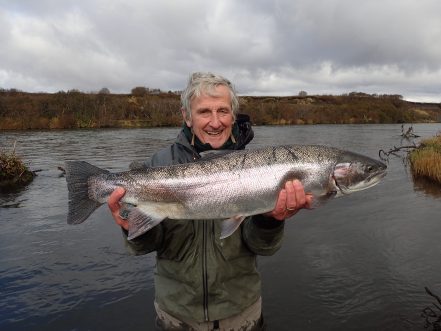
Our good friend and seasoned International fly fishing traveler Tim Hagerty had an amazing steelhead trip on the Sandy River this fall. Check out Tim’s report below…it’s a good one!
This is a report on a unique fly fishing adventure for the elusive and prized quarry, the steelhead. One word – amazing – best describes my experience. I called the river I fished, Steelhead Heaven. The name applies both to the number of bright chrome steelhead hooked and landed each day, and to the remote and pristine Alaska setting where we were fortunate enough to spend a week. I will try to frame what made this fly fishing adventure so special for the author.
This was a fly fishing adventure to a remote part of Alaska on the Aleutian Peninsula, which extends westward towards Russia from the Alaska mainland. Hoodoo’s Sandy River Lodge is 500 miles as a crow flies from Anchorage, and located a short bush plane flight from Port Moller. The focus of my trip was one of the most sought after freshwater species in the fishing world – wild steelhead. Steelhead are ocean-going rainbow trout that grow to salmon size and feed in the ocean for a few years after leaving their natal river, only to return on spawning runs as chrome-bright, feisty fish. They don’t die like Pacific salmon after spawning, and can return 3 or 4 years in a row… and in one documented case, an amazing 8 years! Reaching this extremely remote destination was an adventure in itself.
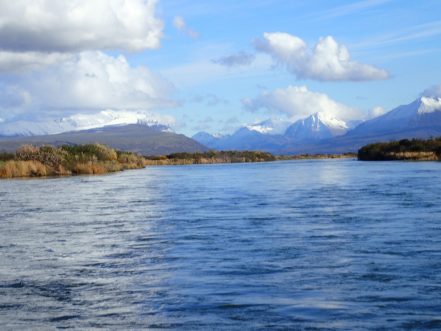
I had the great good fortune in this Covid travel restricted year to have The Fly Shop’s Pat Pendergast find me a rare opening at Rod Schuh’s Sandy River Lodge, to fish the last week of the season. This was mid-October in remote Alaska, not exactly a situation where balmy temperatures were to be expected, or sunblock was going to be needed!
My first hurdle was managing to secure my Covid test near Boston, my home area, then insuring I had it uploaded (negative results only, of course) on Alaska’s Travel Portal correctly with my arrival information. This test must be taken and uploaded within 72 hours of getting on a plane to Anchorage, per Alaska travel guidelines for entry.
Boston had a storm coming right when I was to depart, causing me to change planes 24 hours before take-off, which still insured I would arrive in Anchorage within the 72-hour timeframe. Upon arrival at Ted Stevens International Anchorage Airport we were met by officials who directed us to two lines; here we were checked to make sure we had negative Covid tests uploaded onto the Alaska Travel Portal. I was quickly confirmed, but not all were as prepared. The Fly Shop® had sent separate, updated communications with very clear travel instructions on how to link up with the Alaska Travel Portal. They also recommended a proven Covid test site that used FedEx next day service that would send test results within 48 hours. I did use the test center, obtained the results very quickly, and it was easy to upload onto the portal.
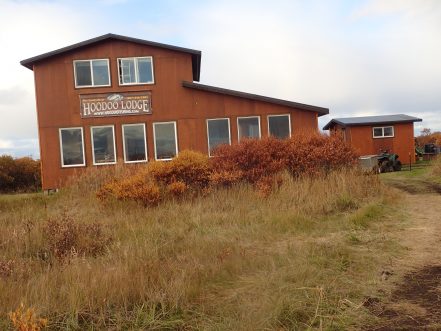
The next step – after spending a night in an Anchorage hotel – was taking a private charter with five other anglers to Port Moller (via Iliamna Air Taxi, a two and a half hour flight). The airstrip at Port Moller is not much; a simple storage building with no terminal or waiting room – just a tarmac landing strip. Rod Schuh, owner of Sandy River Lodge and Hoodoo Lodge, was there to meet us in his DeHavilland Beaver, and flew us and our luggage the 20 minutes to a strip on the Sandy River.
Rod carved out the landing strip himself and does all the flying. Landing on a gravel landing strip scratched out of the tundra, in the middle of nowhere, is always interesting. Rod has been flying since he was a teenager and it was a very smooth, short, fascinating flight. We had a bird’s eye view out the windows at the tundra and various river systems flowing to the Bering Sea.
The next day, after a great breakfast and good coffee we started our first morning loaded up in jet-boats, bundled against the frigid cold. It warmed up for me on my third cast. A chrome steelhead lit up my morning, glinting in the rising sun with the first of what would be several jumps as it tore downstream towards the Bering Sea. That made my day for sure, but the Sandy is a very generous river and four more chromers found their way to net that day (not to mention those I hooked and lost to wild cartwheels and sizzling, reel-burning runs).
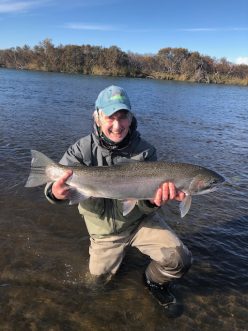
Swinging flies on a Spey rod is the best approach on the Sandy. While I am certainly not a beginner double-handed angler, I had a number of terrible casts the first couple of days. Yet the guides, all excellent steelhead fishermen and patient casting coaches, had me up to speed in no time. They had me self-correcting my casting miscues by the end of day two, which allowed me to focus more on fishing. Their knowledge of the river and its lies for the steelhead was thorough, and I very much enjoyed their company.
The Sandy River is easy to wade, with an exceptionally smooth cobblestone/gravel bottom and no raging, hard-pushing current to contend with. I am 70 years old and had no issue wading anywhere, and never needed a guide’s arm to support me. Yes, I have experience (this was my 47th fly fishing trip to Alaska, all remote fishing – no Kenai River in a boat), but this river was so easy to wade it allowed me to move up and down, deep and shallow, wherever and whenever I wanted.
Our fabulous fishing continued through the week. To qualify “fabulous”, I averaged 5 to 6 steelhead landed a day. No exaggeration. Again, not hooked, but landed steelhead. We all lost several of these wild, crazy fish every day. I had 9 landed one day, and my low day was 3 landed out of 7 hooked. It was common to battle wild and crazy steelhead for some time before they ultimately came unbuttoned. The mean size of the steelhead I landed (not average – mean), was a measured 31 inches. My smallest were a few measured (by tape) to 29 inches. Most were in the 31 to 33 range. The largest I landed (and we taped most all the fish I landed at my request) was 35 inches. Several were also measured at 34 inches.
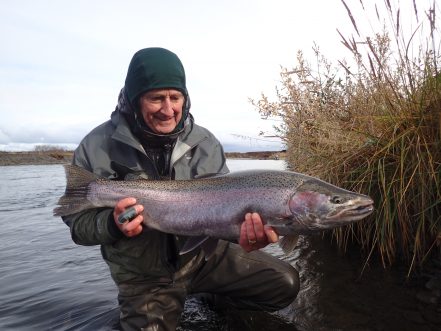
A couple guests said they caught larger steelhead, in the 38-inch class, but I can only report those that I landed and measured, leaving everything else to the reader to ponder. One guest landed 18 steelhead in a single day, confirmed by his guide. This angler was our most experienced steelhead fisherman and along with one another guest had the majority of double-digit steelhead-to-hand days of our week. It was just that wild and good!
I was not in the top 50% of the clients there for numbers of steelhead landed per day, at six, but given this was steelhead fishing and only my second major steelhead trip, I was ecstatic. There was never a dull period of time; my fishing partner (a very good Spey caster and experienced steelheader) and I were almost always swinging over fish.
A couple of years ago I had the privilege of going on The Fly Shop’s unique and special Kamchatka Steelhead Project (KSP) in Eastern Russia. That was my first real steelhead trip, and I was so spoiled from that experience I was hesitant to go fish for steelhead anywhere else. In Kamchatka I landed some larger steelhead than on the Sandy, so I had some basis for comparison when I recommend the Sandy for steelhead. I have not fished the fabled British Columbia steelhead waters, but some in my group of six colleagues had many years of experience there, including the Dean River and using helicopters to access hard-to-reach spots in western Canada. One had also fished the KSP and everyone, without exception, said the Sandy was best steelhead fly fishing they have ever experienced.
I will recommend to all that the Kamchatka Steelhead Project is exceptional and another wild adventure I plan to repeat. It’s the land of giant steelhead and beautiful and remote rivers cultivated, nurtured, and damn well taken care of by The Fly Shop® and their Russian partners; The Conservation Angler; Wild Salmon Center; and Moscow State University. At the KSP, anglers are participants in a scientific study of one of the last vestiges of un-impacted wild steelhead on earth. We tagged, measured and took fin clips of every steelhead we landed – a very rewarding and exciting part of the trip. However, I am signed, sealed and delivered to return to the Sandy next year, same week.
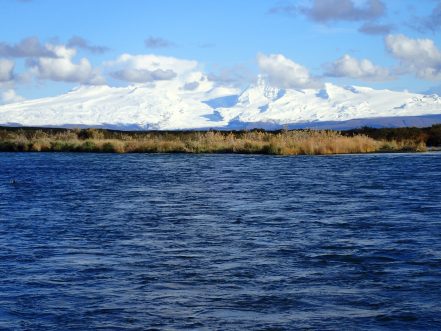
The remote Sandy River Valley is drop dead gorgeous. The scenery towards the headwaters and for 180 degrees surrounding was that of mountains and glaciers interspersed by two dormant volcanos, both with a new covering of termination dust (aka snow). This was in contrast to the other 180 degrees of fall colored tundra and low bush landscape. The Sandy River represents everything that has kept me coming back to Alaska for so many years. No crowds other than a few like-minded anglers in camp, bear viewing at a safe distance allowing one to marvel at these creatures… and you could hear the stillness of this pristine wild remote river and its surroundings. It’s an experience that is harder and harder to find – unpressured waters holding strong populations of one of world’s greatest sportfish. I contrast this to the arguably diminishing steelhead fisheries elsewhere, strongholds of the past…
I used a single-handed 8 weight (Sage Saltwater HD) and a sealed drag Abel SDS reel one morning, managing to land four steelhead. It was a blast and my reel was “singing”. The sealed drag Abel was damn smooth and handled the surges of these great fighters very well, let alone the long initial runs or crazy somersaulting zig zag dances these gonzo steelhead often punish reels with. Many places on the Sandy leave little room for back casts, and there are spots where longer casts are necessary. But certainly this river does lend itself to single-handed rods, overall – just come prepared to double haul High-Speed High Density sink-tips in the 8-weight category more than 40 or 50 feet, and bring a 250-grain sinking tip and (just in case) a floating line with you.
Trying to manage all that line on the water when retrieving after a long cast and having current wash it downstream or tangle in my clumsy hands as I used coils to hold line off water before next cast, tired me out. I do fish single-handed rods in saltwater near my Cape Cod home all season using a stripping basket, but here I feel a double-handed rod is the way to go. I did not notice any diminishment of fight using a double-hander versus a single-hander. These are great fighting fish, period. Double-handed rods cover water more easily and, when needed, give you greater distance… and we needed that at times.
I fished two rods the majority of the time, a 7-weight double-handed Scott Radian, and Sage X single-handed 8-weight. The large arbor Hatch reels I used on my spey outfits were flawless, reels I also used in Kamchatka for steelhead, and for very large striped bass and hard-running false albacore on the Cape. Hatch reels have an exceptionally smooth drag with low inertial startup which handled these steelhead with ease. Skagit heads with 7.5 to 10 feet of T-11 were perfect for the river, as well. When the water is higher, I am told T-14 heads comes in very handy. All my gear is from The Fly Shop®. As with us all I have options regarding where I shop, yet I like their service, product offerings, return policy and especially their knowledge base when I call in with questions.
We experienced real steelhead fishing weather and there were several mornings where we had ice in our guides. Except for one day during our stay, it always warmed up by late morning and early afternoon. Even with cold water temperatures in the morning, fishing sessions by mid-morning saw us regularly moving fish.
Hoodoo Lodge on the Sandy River was constructed by Rod and his crew (he flew in all building materials himself) in the middle of nowhere, or so it seemed. It accommodates a maximum of six anglers between four rooms and includes two bathrooms and showers. Guide and cook quarters are in another building. Everyone enjoyed the warm-as-toast wader and gear drying room (boy did I appreciate that). We were well taken care of, and meals were excellent and quite filling if we could get past the hors d’oeuvres, which to me were a meal by themselves. I am a coffee snob and I even liked the coffee they served! Everything here functioned perfectly, all in the middle of nowhere and miles away from any sort of human habitation.
Yes, the lodge had internet and we were able to use our cellphones and call anyone and anywhere we wished using voice-over internet, with excellent speed to boot. The cook even asked us twice to put down our cell phones and pay attention to the subject at hand!!
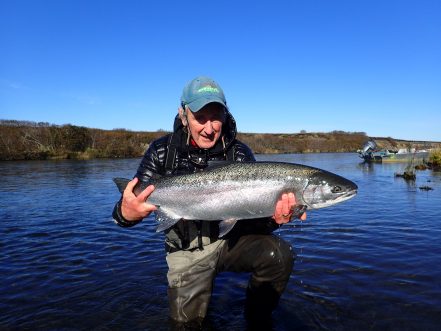
Rod Schuh also owns the very well-regarded Hoodoo Lodge upriver from Nelson Lagoon on the Sapsuk River, further down the peninsula. Both the Sapsuk and the Sandy have excellent, fresh-from-the-salt fly fishing for king salmon and rods are hard to get – the word has spread. Remote out camps are also available to clients who book his Hoodoo Lodge. Rod is hands-on and everything was very well-executed. The guides I had were world-class and helped with advancing my spey casting and understanding more about steelhead lies, drifts, flies and more. Rod also operates a hunting operation in this area.
I hope this report is of some relevance to anyone who loves steelhead fishing and is looking for special places to consider. It’s here and The Kamchatka Steelhead Project where I intend to focus my steelheading in the future. I also plan to fish for bright king salmon on the Alaska Peninsula where I explored and caught sea-liced Chinooks on small rivers in 2010…but that is another story. Call The Fly Shop® for more information.
Sincerely,
Tim Hagerty
P.S. I have no association with The Fly Shop® or any lodges except when I book. I write this on my own volition and with no financial or other issues influencing me.
Alaska lodge availability next summer will be tight, but space still exists. If you are interested in fishing Alaska next summer, please don’t delay in making your plans. We have our fingers on the pulse of current availability and can help you with your 2021 Alaska fishing plans. Give us a call at (800) 669-3474, or email us at travel@theflyshop.com.
If you are interested in fishing Lava Creek Lodge next summer or fall, we have some excellent weeks available.
The Fly Shop Team
travel@theflyshop.com
(800) 669-3474 • (530) 222-3555


